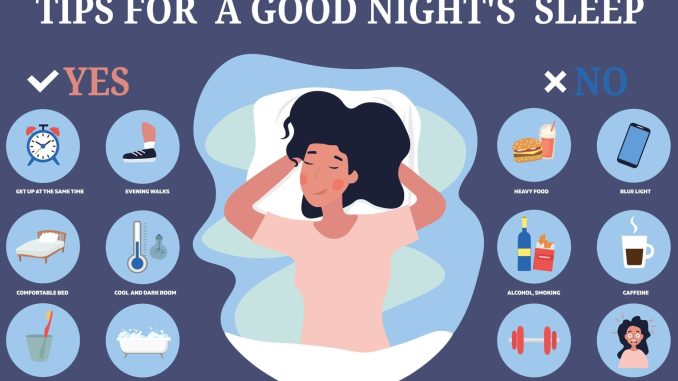
In our relentlessly fast-paced world, where productivity often reigns supreme and the lines between work and leisure blur, sleep is often the first casualty. Many view it as a luxury, a mere pause in the day’s demands, rather than a fundamental pillar of health and well-being. However, the scientific consensus is unequivocal: quality sleep is not negotiable. It is a critical biological necessity that underpins virtually every aspect of our physical and mental health, influencing everything from cognitive function and mood regulation to immune response and metabolic balance. When sleep is consistently compromised, the ripple effects can be detrimental, impacting productivity, relationships, and overall quality of life. Fortunately, for those struggling with restless nights, the solution often lies in cultivating what experts refer to as “sleep hygiene”—a comprehensive set of practices and habits that are conducive to sound, restorative sleep.
One of the most foundational elements of effective sleep hygiene is establishing a consistent sleep schedule. Our bodies thrive on routine, and our internal circadian rhythm, often called the “body clock,” is no exception. Going to bed and waking up at roughly the same time each day, even on weekends, helps to regulate this rhythm, signaling to your body when it’s time to be alert and when it’s time to wind down. Irregular sleep patterns, on the other hand, can disrupt this delicate balance, leading to feelings of jet lag and making it harder to fall asleep and wake up naturally. Imagine a finely tuned orchestra; if each musician starts playing at a different time, harmony is lost. Similarly, a consistent sleep schedule ensures that all your body’s internal systems are in sync, optimizing the conditions for restful sleep.
The bedroom environment itself plays a crucial role in promoting sleep. Creating a sanctuary conducive to rest involves optimizing several sensory inputs. Firstly, darkness is paramount. Even small amounts of light, particularly blue light emitted from electronic screens, can suppress the production of melatonin, the hormone that signals to your body that it’s time to sleep. Investing in blackout curtains, using an eye mask, and ensuring all electronic devices are off or covered can significantly enhance melatonin release. Secondly, temperature matters. Most experts agree that a cool room, typically between 18-20 degrees Celsius (65-68 degrees Fahrenheit), is ideal for sleep, as it aligns with the natural drop in body temperature that occurs as we prepare for rest. Thirdly, minimize noise. A quiet environment is essential, but if complete silence is unattainable, consider using earplugs or a white noise machine to mask disruptive sounds. Finally, ensure your mattress and pillows are comfortable and supportive, as physical discomfort can severely impede sleep quality.
Beyond the bedroom’s physical attributes, daily habits significantly influence our ability to achieve restorative sleep. What you consume, and when, directly impacts your sleep architecture. Caffeine, a potent stimulant, should be avoided in the late afternoon and evening. While it may offer a temporary energy boost, its effects can linger for hours, interfering with sleep onset. Similarly, alcohol, though it may initially induce drowsiness, ultimately disrupts sleep cycles, leading to fragmented and less refreshing sleep. Nicotine, another stimulant, also warrants avoidance close to bedtime. Furthermore, eating heavy meals too close to bedtime can lead to indigestion and discomfort, making it difficult to fall asleep. Opt for lighter, easily digestible snacks if hunger strikes late in the evening.
Managing stress and mental activity before bed is another critical component of good sleep hygiene. In today’s demanding world, it’s common for minds to race with worries, to-do lists, and reflections on the day. Engaging in stimulating activities like intense work, vigorous exercise, or emotionally charged discussions too close to bedtime can keep the brain in an aroused state. Instead, cultivate a relaxing pre-sleep routine. This might involve reading a physical book, taking a warm bath, listening to calming music, practicing gentle stretching or yoga, or engaging in mindfulness and meditation exercises. The goal is to signal to your body and mind that it’s time to transition from activity to rest, allowing your brain to gradually slow down and prepare for sleep.
Regular physical activity during the day can profoundly improve sleep quality, but timing is key. Engaging in moderate to vigorous exercise earlier in the day or in the late afternoon can promote deeper, more restorative sleep by reducing stress and improving overall physical well-being. However, intense exercise too close to bedtime can be counterproductive, as it raises body temperature and stimulates the nervous system, making it harder to fall asleep. Aim to complete your workouts at least a few hours before your intended bedtime.
Finally, managing daytime napping requires careful consideration. While a short power nap can be refreshing for some, long or late-afternoon naps can disrupt the body’s natural sleep-wake cycle, making it difficult to fall asleep at night. If you must nap, try to keep it short (20-30 minutes) and take it earlier in the afternoon to avoid interfering with nocturnal sleep.
In conclusion, prioritizing and improving sleep hygiene is not a luxury but a strategic investment in overall health and productivity. By meticulously cultivating a consistent sleep schedule, optimizing the bedroom environment for darkness, coolness, and quiet, making conscious choices about diet and stimulants, establishing a relaxing pre-sleep routine, and timing exercise appropriately, individuals can significantly enhance the quality and quantity of their sleep. This commitment to restorative sleep is a powerful pathway to improved cognitive function, emotional resilience, physical vitality, and ultimately, a more fulfilling and healthier life.